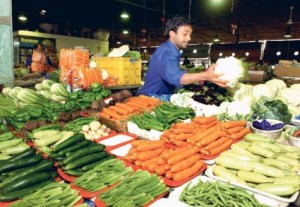The National | 18 April 2010
by Sean Cronin
Anyone who has lived on a farm knows the chores of agricultural life are rarely glamorous. From mucking out byres to assisting the vet at the business-end of calving season, the real pastoral life is no Constable oil painting.
But the only chore that really got me down as a reluctant schoolboy farmer was removing stones from the barren scraps of rock and bog that passed for our fields.
The stones needed to go before the plough could move in, then the harrow, then the big steel roller and after all that time, which fitted neatly into a summer school holiday, you would have something not entirely unlike arable land – able to support a few grazing cows or sheep instead of just the solitary peckish rabbit.
Days and weeks would pass plucking rock after rock from the ground to be tossed into a hydraulic tractor box and hauled away for burial in deep holes, helping to confuse archaeology students of the future.
It was a soul-destroying job and one that seemed hard to justify, I reasoned back then, especially as it lacked any tangible form of remuneration other than cheese sandwiches at lunchtime.
At the end of every day, it would seem to me that there were exactly the same number of rocks in that field as the beginning.
While Sisyphus spent all eternity pushing big stones up hills, it felt like I was spending one pulling them out of fields. Had he been a contemporary, this surely would have been his punishment. Instead, it was mine.
I vowed that whatever happened when I finished school I would choose a job that involved as little labour as possible and rewarded idleness. Journalism beckoned, and that is how I came to work for The National.
A quarter of a century later, the fields of my youth have become forests of conifers. In what now seems like a cruel joke, the Irish government of the mid-1980s decided to give farmers big grants to plant trees on what was euphemistically described as “marginal land”. We knew it as “bog”.
Farmland, or more especially bogland, was seen to have such little intrinsic value back in those days that the government, helped by Europe’s wallet, happily dished out 85 pence for every £1 spent planting trees that would take 30 years at best to yield a relatively modest return on investment.
It was a time of agricultural oversupply in Europe when the newspapers were filled with stories about “milk lakes” and “butter mountains” created by a Common Agricultural Policy that was then functioning only as a mechanism to reward farmers for producing food that people in Europe weren’t hungry enough to consume – while those in Africa starved.
How times change. In the last few years, agricultural land has become hot property, benefiting to a large extent from strengthening commodity markets.
But farmland is not just a cyclical commodity play anymore, as it was in 2008 when oil at US$147 a barrel encouraged a surge of land acquisitions by Gulf states looking to their long-term food security.
According to the International Food Policy Research Institute, in the last four years alone about 20 million hectares of farmland in developed countries have been involved in transactions with foreign investors.
That’s about the size of France’s agricultural land mass, the UN special rapporteur on the right to food pointed out in a recent article.
Just last week, the Egyptian buyout company Citadel Capital signed a 30-year lease for about 25,000ha of land in Sudan, joining a long list of acquisitions involving Middle East investors in recent years.
It is no accident that most of these deals involve land in the developing world, which is where a problem arises.
Governments around the world have been preoccupied with limiting economic damage for the past two years as countries emerge from the global financial crisis and fiscal stimulus measures are wound down. Such measures continue to dominate every gathering of world leaders and academics from Davos to next week’s IMF and World Bank spring meetings in Washington.
When one recalls the international hullabaloo surrounding the proposed acquisition of some US ports by DP World a few years back and the related noises made in North America and Europe over the buying activity of sovereign wealth funds, it seems odd now that the purchase of vast tracts of land around the planet by a relatively small group of investors is taking place with seemingly little attention paid by world leaders.
Such huge transfers of agricultural power must surely come with consequences that are worthy of closer regulatory inspection.
With as many as 4 billion more mouths to feed over the next half century, the ownership of the world’s ports is less of a worry to me right now than the ownership of its fields.
One of the big themes of the last World Economic Forum in Davos was how the global financial system may have been better served if it had the same kind of rules that governed global trade.
It could be time to start thinking in the same way about large-scale cross-border agricultural investments.
[email protected]












